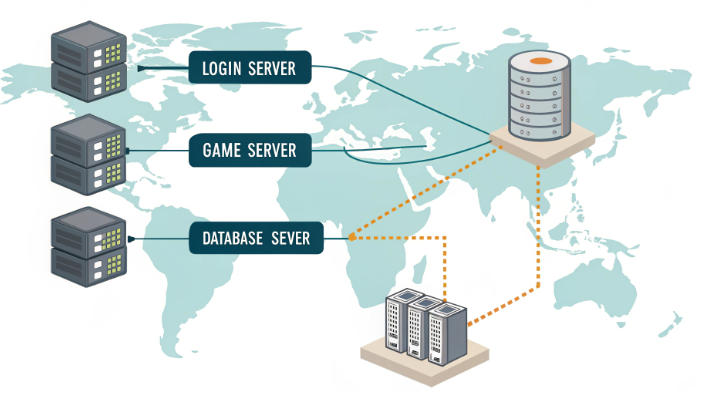Global Game Server Architecture Insights

In the ever-expanding landscape of global gaming, creating a seamless experience for players across continents demands a robust game server global architecture. This technical deep dive explores the core components, challenges, and optimization strategies essential for building systems that handle concurrent users, minimize latency, and ensure data consistency worldwide.
The Foundation of Global Game Server Architecture
Modern global architectures rely on distributed systems design to overcome geographical barriers. Key considerations include:
- Multi-data center deployment to reduce latency, with strategic node placement ensuring under 100ms round-trip time for target user bases
- Hybrid cloud models combining public cloud scalability with private infrastructure control for critical workloads
- Edge computing integration to push processing closer to end-users, reducing packet travel distances and improving responsiveness
Distributed Systems Design Principles
Building a scalable architecture requires mastering distributed computing fundamentals:
Data Center Placement Strategies
Regional hubs act as backbone nodes, connecting local edge locations. Key factors in selecting hub locations include:
- Network connectivity: Proximity to major internet exchanges and low-latency links to target regions
- Regulatory compliance: Adherence to local data protection laws like GDPR and CCPA through localized storage policies
- Infrastructure redundancy: Designing failover mechanisms to reroute traffic within 500ms during node outages
Load Balancing Mechanisms
Effective load distribution ensures optimal resource utilization:
- Geolocation-based DNS routing to direct users to the nearest operational node
- Dynamic load balancers using algorithms like least-connection and weighted-round-robin to balance traffic in real-time
- Application-layer optimization through connection pooling and request queuing to manage sudden traffic spikes
Low-Latency Networking Strategies
Network performance is make-or-break for global gaming experiences. Critical optimization techniques include:
Protocol Innovations
Traditional TCP protocols often fall short for latency-sensitive applications, leading to the adoption of specialized alternatives:
- KCP: A congestion-controlled protocol offering 30% lower latency than TCP through selective acknowledgments and adaptive retransmission
- QUIC: Google’s UDP-based protocol combining low latency with TLS encryption, reducing handshake delays by 50% on subsequent connections
- Custom binary protocols optimized for game-specific data structures, minimizing payload sizes and parsing overhead
Anti-Jitter Mechanisms
Unreliable networks require robust error correction:
- Client-side prediction to simulate server state updates locally, smoothing out perceived latency during temporary network issues
- Server-side rollback algorithms that revert game states to known good checkpoints when packet loss exceeds 15%
- Adaptive bitrate adjustment based on real-time network metrics, ensuring stable throughput across varying connection qualities
Data Consistency Across Borders
Maintaining coherent game states in distributed systems presents unique challenges:
Cross-Region Synchronization Models
Architectures must balance consistency with performance through hybrid strategies:
- Strong consistency for critical operations like in-game purchases, using distributed transaction protocols (e.g., two-phase commit)
- Eventual consistency for non-critical data (e.g., player statistics), implemented via message queues like Kafka for asynchronous replication
- Vector clock algorithms to resolve version conflicts in distributed key-value stores, ensuring causal order preservation
Compliance and Data Sovereignty
Navigating regional regulations requires deliberate data partitioning:
- Localized storage of personally identifiable information (PII) in compliance with GDPR, CCPA, and other regional frameworks
- Encrypted cross-border data transfers using protocols like IPsec and TLS 1.3 to maintain security during synchronization
- Regular compliance audits and penetration testing to identify vulnerabilities in data handling workflows
Resource Management and Scalability
Handling unpredictable traffic patterns demands elastic infrastructure design:
Dynamic Resource Provisioning
Modern architectures leverage machine learning for intelligent scaling:
- Q-learning based algorithms to predict resource demands up to 30 minutes in advance, triggering auto-scaling events before traffic spikes
- Containerized deployments using Kubernetes for rapid resource allocation, achieving 90% faster scaling compared to traditional virtual machines
- Serverless functions for stateless operations, reducing overhead for intermittent workloads like authentication and matchmaking
Cost Optimization Techniques
Balancing performance with expenditure involves strategic resource allocation:
- Spot instance utilization for non-critical workloads, achieving cost savings of up to 40% compared to on-demand pricing
- Bandwidth optimization through traffic compression (e.g., Brotli for text data, WebP for images) and deduplication
- Idle resource reclamation using timeout mechanisms to terminate unused instances after 15 minutes of inactivity
Future Directions in Global Architecture Design
As gaming technology evolves, architecture paradigms continue to advance:
Edge Computing Integration
Deploying micro-data centers at network edges offers significant latency reductions:
- 5G edge nodes reducing local user latency by 20-30%, enabling real-time interactions in AR/VR gaming experiences
- Cloud-edge协同 (cloud-edge collaboration) architectures for hybrid workloads, offloading latency-sensitive tasks to edge devices
- Edge-native security frameworks to protect distributed endpoints from emerging threats
AI-Driven Optimization
Machine learning enhances various architectural components:
- Deep learning models for predictive traffic routing, improving path selection accuracy by 25% compared to rule-based systems
- Reinforcement learning for autonomous failover, reducing mean time to recovery (MTTR) from 30 seconds to under 5 seconds
- Anomaly detection using neural networks to identify distributed denial-of-service (DDoS) attacks with 99.2% accuracy
Designing a game server global architecture that meets the demands of modern cross-region gaming requires a blend of networking expertise, distributed systems knowledge, and regulatory awareness. By focusing on low-latency communication, data consistency, and elastic scalability, developers can create infrastructure that supports global player bases while adapting to emerging technological trends. As the industry continues to globalize, prioritizing these architectural fundamentals will be key to delivering seamless, reliable gaming experiences worldwide.

